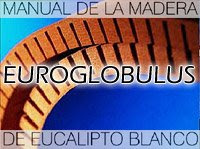Eucalyptus fastigata & Eucalyptus sieberi in Galicia: Siblings of Tasmanian Oak
Gustavo Iglesias Trabado 
GIT Forestry Consulting - Consultoría y Servicios de Ingeniería Agroforestal - www.git-forestry.com - EUCALYPTOLOGICS

GIT Forestry Consulting - Consultoría y Servicios de Ingeniería Agroforestal - www.git-forestry.com - EUCALYPTOLOGICS
We bring you today two rare examples of Ash ("Fraxinus wood like") Eucalyptus growing in Galicia (Northwestern Spain).
 Fig.1: Eucalyptus fastigata and Eucalyptus sieberi in Galicia, Northwestern Spain. (Click to enlarge)
Fig.1: Eucalyptus fastigata and Eucalyptus sieberi in Galicia, Northwestern Spain. (Click to enlarge)To the left, E. fastigata, the Brown Barrel, with natural habitat ranging from the highlands of Gippsland (Victoria) through the Great Dividing Range to New England (New South Wales) in Australia. To the right, E. sieberi, the Silvertop Ash or Black Ash, with natural habitat in NSW, Victoria and Tasmania.
Both species belong to series Obliquae, being close relatives of other relatively cold hardy Monocalyptus as E. pauciflora and its remarkable frost tolerant subspecies niphophila and debeuzevillei, E. delegatensis and its subspecies, E. regnans, E. gregsoniana, E. fraxinoides, E. lacrimans and, of course, E. obliqua.
The Brown Barrel received its botanical name after its columnar and stylised growth habit ("fastigatum") and the Black Ash honours Franz Wilhelm Sieber (1789-1844), a Czech-German botanist that, among other travels around the world and plant collections, visited New South Wales by 1823 and collected and later named E. pauciflora. So responsible of a funny eucalyptic fact.
Two groups of eucalypts are commonly cultivated worldwide within this Monocalyptus / Obliquae part of taxonomy. One one hand, the Snow Gums, that have spread to temperate areas of the world because of their extreme tolerance to cold, ability to resist frost and snow.
On the other hand and thinking now in timber terms, the Tasmanian Oaks or Robles de Tasmania, not all of them really Tasmanian, but that could be grouped within that commercial name for lumber considerations. These are known all over the world for their excellent wood properties and noble uses as splendid furniture or beautiful flooring.
On the other hand and thinking now in timber terms, the Tasmanian Oaks or Robles de Tasmania, not all of them really Tasmanian, but that could be grouped within that commercial name for lumber considerations. These are known all over the world for their excellent wood properties and noble uses as splendid furniture or beautiful flooring.
 Fig. 3: Eucalyptus delegatensis ssp. tasmaniensis (Tasmanian Oak) timber plantation in Galicia, Northwestern Spain. (Click to enlarge)
Fig. 3: Eucalyptus delegatensis ssp. tasmaniensis (Tasmanian Oak) timber plantation in Galicia, Northwestern Spain. (Click to enlarge)With suitable silviculture including pruning and thinning, appropriate genetic background for the seedlings used in reafforestation and some patience using longer rotation cycles, Tasmanian Oak can be an interesting alternative for high value timber production in cold temperate areas of Northwestern Spain. Its fast growth compared to conifers and other broadleaved species and higher tolerance to frost than E. globulus make it suitable for farm forestry in the highlands.
- Brooker, M.I.H. (1977) Internal bud morphology, seedling characters and classification of the ash group of euclaypts. Australian Forest Research 7(3):197-207
- Wilcox, M.D. (1979) The ash group of eucalypts. New Zealand Journal of Forestry Science 9(2):133–144.
- Revell, D.H. (1981) Silviculture of eucalypts: New Zealand experience. In "Wood: Future Growth and Conversion". Workshop Proceedings, Canberra, Australia. Bachelard E. P. & Hillis W. E. (eds.)
- Wilcox, M.D. (1982) Genetic variance in frost tolerance, early height growth and incidence of forking among and within provenances of Eucalyptus fastigata. New Zealand Journal of Forestry Science 12(3):510–524.
- Haslett, A.N. (1988) A guide to handling and grade-sawing plantation-grown eucalypts. New Zealand Forest Research Institute. FRI Bulletin Nº 142.
- Barr, N. (1996) Growing Eucalypt Trees for Milling on New Zealand Farms. New Zealand Farm Forestry Association Inc.
![]() Subscribe to receive EUCALYPTOLOGICS via RSS
Subscribe to receive EUCALYPTOLOGICS via RSS
© 2007 Gustavo Iglesias Trabado. Please contact us if you want to use all or part of this text and photography elsewhere. We like to share, but we do not like rudeness.



































![Validate my Atom 1.0 feed [Valid Atom 1.0]](http://gus.iglesias.googlepages.com/valid-atom.png)



















0 Comments by our readers :::
Send a comment to EUCALYPTOLOGICS